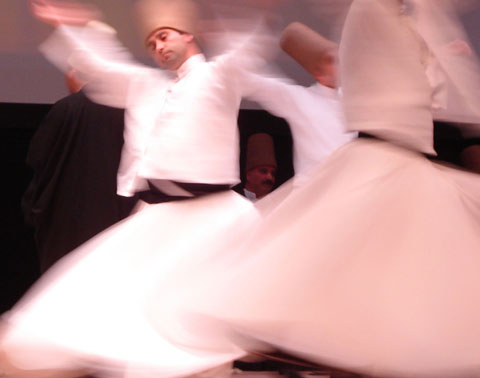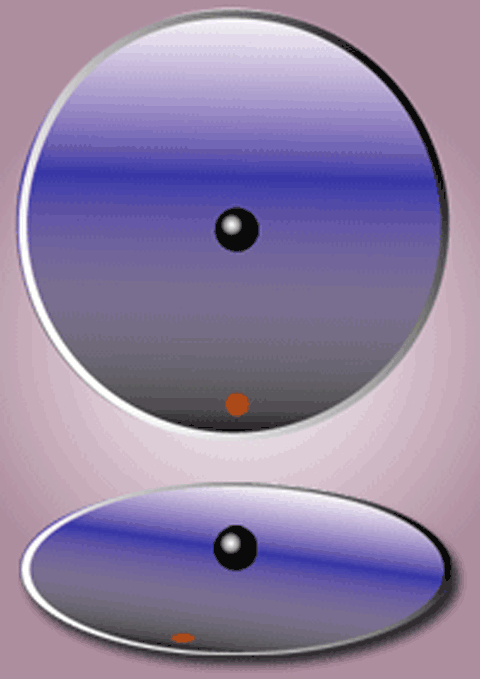Whirling Skirts Reveal Steady Patterns
February 25, 2014
What do the whirling conical fabrics worn by Muslim ascetics have in common with the Earth’s atmosphere? Quite a bit, actually. A recent study found that the Coriolis effect, which explains much of the large-scale of airflow in our atmosphere, also forms the backbone of solutions for the patterns formed on these rotating skirts.1

Photo of whirling dervishes at the 2007 Rumi Fest.
Image Credit: diaz via Wikimedia Commons
Centripetal vs. Centrifugal
Whenever an object is changing its velocity (speed and/or direction) it has an overall force (push or pull) acting on it. If an object is rotating at a constant rate, it is constantly changing direction, and hence it has a force on it.
The force required to turn an object, as described in an inertial reference frame (one that is not accelerating, and therefore not rotating) is called the centripetal force. It points toward the axis of rotation, and acts to keep pulling the object inward so it does not fly off.
Imagine sitting in a rotating object, such as a car going around in a circle, or on a rotating platform. As you go around the circle in a car, you slide toward the door and you feel pushed into the door.
In this rotating frame you feel like there is a force pushing you radially outward, toward the door: the centrifugal force. But this force only exists in this rotating, non-inertial reference frame. Once you reach the door, the door pushes you back toward the axis of rotation.
Friction from the seat also pushes you in toward the axis of rotation. Even though you may “feel” that there is a force pushing you toward the door, it isn’t really there. Actually, your moving body tends to stay in an unchanged motion unless a force acts on you.
Your body is headed in some direction with the car, say north, but the car begins to turn west, and your body still is heading north, until something in the car (friction from seat or a push from the door) can turn you to the west. The door simply impedes the natural direction your body wants to travel due to the initial direction you were traveling.
Coriolis Effect
Back in 1835, a paper by Gaspard-Gustave de Coriolis’ discussed the dynamics of a water wheel and forces in a rotating reference. The forces he described has since been called the Coriolis force and the centrifugal force. The centrifugal force is a radially outward force while the Coriolis force is perpendicular to the centrifugal force.
To an observer in a rotating reference frame, both of these forces are needed to describe the motion of a thrown ball.
A rotating reference frame is a non-inertial frame, one that is accelerating, and hence these forces are a result of being an observer in this non-inertial reference frame. They are considered “effective” or fictitious forces because they do not exist in a non-rotating reference frame.
But the Coriolis effect is a real effect: It is how an object appears to move when viewed in a rotating reference frame. For example, if you (represented by the red dot in the image) are standing on a whirling merry-go-round and observe a bird flying in a straight path (black dot), the bird will appear to fly in a curved path.
An illustration of this is shown below. The top image shows what the bird’s path looks like to someone standing on the ground watching, and the bottom image shows what the bird’s path looks like to the person on the whirling merry-go-round.
For the observer in the rotating reference frame, because the bird is changing direction, the bird must have a force acting on it. The direction radially outward from the center will be in the direction of the centrifugal force acting on the bird, and the direction perpendicular to that, causing the bird to turn will be the Coriolis force acting on the bird. These do not exist in an inertial reference frame.

From a non-accelerated (inertial) reference frame, the black ball (bird) moves straight across, but too the person (red dot) observing in the rotating reference frame the black ball (bird) seems to move along a curved path.
Image Credit: Hubi via Wikimedia Commons
In other words, if you are in a rotating frame you consider yourself as stationary, and something flying in a straight path appears to go in a curved path.
But now consider rolling a ball in a straight path, while you are on a rotating merry-go-round. The ball appears to go in a straight path according to someone viewing the merry-go-round from above, but in a curved path when viewed from someone on the merry-go-round.
This situation is slightly different than the first situation we described. Before the ball is pushed, it already has the same rotational motion as that of the merry-go-round. According to Newton’s laws, it must keep this rotational motion, along with the motion due to the push, as it does. You can watch a video of this at the bottom of this webpage.
Similarly, the Earth’s rotation from West to East about its axis affects weather patterns across the globe. Anything on Earth rotates with Earth, so it already has motion in that direction.
The clouds rotate counterclockwise in the northern hemisphere and clockwise in the southern hemisphere. Storms like cyclones and hurricanes rotate counter clockwise in the northern hemisphere and clockwise in the southern hemisphere.
These directions result from air near the surface moving in the direction of Earth’s rotating surface and air moving above interacting with this. The speed, from West to East, at Earth’s equator is faster than it is at the poles because it has a greater distance to travel, and all of Earth rotates at the same rate. A three minute video by NOVA about this is embedded below.
Whirling Skirts
So what does this all have to do with spinning skirts? To answer that question, we first need a better understanding of just how these skirts work.
The skirts are made of unpleated fabric cut from a cone shape. When the skirts are not whirling around, they hang down like a drape. When the skirt begins rotating, it lifts from the ground a bit. While whirling, a pattern of three or four sharp crests separated by broad troughs emerges.
Both the pattern and the fabric rotate, but, surprisingly, they rotate at different rates. The rotation of the pattern is slower than the rotation of the flowing fabric.1 If you watch the video closely you can see that the fabric of the skirt is flowing more rapidly than the sharp crests.
Researchers from the University of Mexico, Virginia Tech, and the University of Lorraine in France, constructed a simple mathematical model to investigate this phenomenon. Their model neglects factors such as the stretching of fabric, its bending energy, the uneven mass distribution, and interactions with the air.1
They used a cone shape for the skirt with a 1 m radius at the end. If the bottom of the skirt rotates at 1 Hertz (1 rotation per second) then it experiences accelerations of about four times greater than the acceleration due to gravity (4 g’s).
This large acceleration gave the researchers a justified reason to neglect the gravitational pull on the fabric by Earth. Using this simple, but still non-linear, model, the researchers looked for equations that produced patterns similar to the patterns they observed in the whirling skirts.
They were surprised to find that they could not reproduce any of the patterns observed unless they included the relative motion between the fabric of the skirt and the pattern formed. The Coriolis forces on the fabric appear to play an essential role in the formation of the pattern observed.
By adjusting the parameters of their updated mathematical model to include the relative motion between the fabric of the skirt and the pattern formed, they were able to reproduce standing patterns that exhibit three sharp crests extremely similar to the patterns observed on the Whirling Dervish’s skirt. You can see the results alongside a photo of a Whirling Dirvish in reference 1, linked here.
An example of one solution to their refined mathematical model is shown below. The colored cone represents the skirt. The black line is fixed in position at a crest or peak of the pattern that is formed. It rotates around the vertical axis along the cone. The red line is a fixed line on the fabric of the skirt.
Both black and red lines are at the same location in the first image below. In the second image, you can see that the fabric of the skirt is rotating faster than the standing pattern, indicated by the further rotation of the red line with respect to the black line fixed on a crest in the pattern.
This fabric continues to move at a steady rate greater than that of the pattern, and hence the angle between the lines increases in time, as shown in the next two images.

Snapshots in time of rotating pattern and fabric for the simple model described above of a rotating, unstretchable, cone shaped skirt. Time increases from left to right.
Image Credit: J. Guven/JA Hanna/M.M. Muller
Looking Ahead
As the researchers note in their paper,1 the pattern formation in this flowing skirt has many similarities but also a few differences from pattern formation in rotating liquids or gases. For instance, the rotation of a liquid or gas allows the material to travel throughout the rotating volume.
For the skirt, the pattern and the flow are confined to the surface, as it would be on a rotating string. This involves strong constraints on the equations that describe the motion of the rotating fabric.
According to one of the researchers, J. Guven, they “are currently attempting to understand the extraordinary variety of patterns predicted by the equations.” In their paper,1 they describe that they also plan to refine their model by removing various simplifications that were used.
For example, they plan to include the effects of gravity on the fabric, as well as its bending energy. As Guven puts it, “These are important considerations if you are interested in modeling the movement of less insubstantial materials.”
References and Resources
1. Guven, J, Hanna, J.A., Müller, M.M, Whirling skirts and rotating cones, New Journal of Physics, 15 (2013)http://iopscience.iop.org/1367-2630/15/11/113055/article
2. Kemsely, T., Movement Patterns in Whirling Dervishes’ Skirts Linked to Force that Makes Cyclones Spin, Nature World News, 29 Nov 2013
http://www.natureworldnews.com/home/news/services/print.php?article_id=5110
—H.M. Doss














